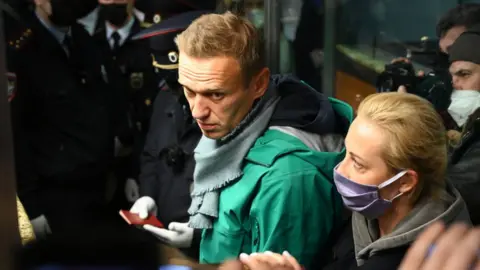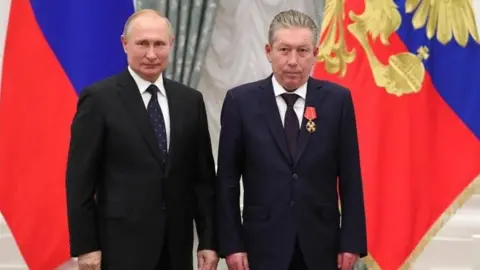By Graeme BakerBBC News

 Getty Images
Getty ImagesDays after the death of Alexei Navalny was first reported, details about what happened to him remain scarce.
According to Russian accounts, the 47-year-old took a short walk at his Siberian penal colony, said he felt unwell, then collapsed and never regained consciousness.
On Saturday, Navalny’s family confirmed that the political activist died at 14:17 local time (09:17 GMT) on Friday 16 February.
The authorities at the prison where he was held said he suffered “sudden death syndrome”, his team reported. It is not clear if an autopsy has been performed yet on his body.
It is also not clear where his body is. Navalny’s mother Lyudmila, who arrived in the area on Saturday, has now visited the mortuary in the town of Salekhard near the prison, where she was told his body had been taken.
A spokesperson for the politician, Kira Yarmysh, said Lyudmila was not allowed inside the facility and that her son’s lawyer was pushed out of the building. The staff did not confirm whether his body was there.
According to Ms Yarmysh, an investigation by a Russian committee into the death has been extended indefinitely.
She had already been told by officials that Navalny’s body would not be handed over until this was completed.
Ms Yarmysh later said that investigators had told Lyudmila they would not hand over the body for two weeks while they conducted a “chemical analysis”.
Opposition leader appeared in good health before death
Navalny’s condition had deteriorated in his three years in prison, where he complained of being denied medical treatment and had spent almost 300 days in solitary confinement. By the time of his arrest in January 2021, he had spent months recovering from a nerve agent attack.
Even so, he appeared to be in relatively good spirits and health in a court video a day before his death.
The weight of international opinion does not appear to tally with Russia’s account of what happened to him at IK-3, or “Polar Wolf” – one of Russia’s northernmost and toughest prisons.
French Foreign Minister Stéphane Séjourné said Navalny “paid with his life” for his “resistance to Russian oppression”, adding that his death was a reminder of the “reality of Vladimir Putin’s regime”.
Navalny’s mother said her son was “alive, healthy and happy” when she last saw him on 12 February, in a Facebook post quoted by Novaya Gazeta newspaper.
His wife, Yulia, said simply: “We can’t really believe Putin and his government.”
What Russian reports say about his collapse
Russia’s Interfax news agency reports that medics spent half an hour trying to resuscitate him.
According to prison authorities, doctors were with him within two minutes and an ambulance was available within six.
The state-run RT network – banned in many Western countries – raised the possibility that a blood clot killed him. Dmitry Peskov, Mr Putin’s spokesman, said “medics must somehow figure this out”.
Previous attempts on Navalny’s life
Whether it was slow deterioration, a sudden catastrophe or a single incident that killed him, Navalny was aware people wanted him dead.
In December 2020, Navalny accused agents from Russia’s security agency, the FSB, of poisoning him.
He had fallen gravely ill and collapsed on a plane flying out of Tomsk, Siberia, forcing the plane into an emergency landing in Omsk as the crew sought medical aid.
European labs would later confirm that Novichok, the Russian-made nerve agent also used to poison Sergei and Yulia Skripal in Salisbury in the UK, was found on his body.
In an extraordinary phone call, which Navalny recorded, he duped an FSB agent into admitting that the chemical weapon had been administered to Mr Navalny’s underwear at a hotel in Tomsk. The agent, Konstantin Kudryavtsev, said that had the plane not made an emergency landing, he would have died.
After treatment in Germany, Navalny returned to Russia in January 2021 and was instantly arrested.
His health worsened in prison
In the months that followed Navalny’s imprisonment on charges of “extremism” and “corruption”, various warnings from his allies and lawyers were issued that his condition was worsening, that he was gravely ill, or that his whereabouts were unknown.
He complained of severe back pain, fevers and numbness in his legs. He spoke of sleep deprivation due to hourly “checks” by guards shining torches in his eyes, and was still not over the severe effects of the nerve agent attack.

 Getty Images
Getty ImagesSuspicious fate of Putin rivals
Navalny’s history of activism would mark him out as a primary threat to Putin’s power.
For more than a decade, he exposed corruption within the regime, while his video investigations received hundreds of millions of views online.
Then in 2021, his campaign team produced a viral video aiming to expose the building of a $1bn palace for Putin on the Black Sea, funded by “the largest bribe in history“.
Navalny said it was evidence of Vladimir Putin’s “feudal” regime of patronage and thievery from the Russian people. The video has been viewed almost 130 million times in three years.
Mr Navalny was already in custody by the time the video was released. And now he is dead.
He becomes the latest name on a long list of people to have suffered “sudden Russian death syndrome”, as some commentators have framed it.
It includes not only out-and-out Putin critics, but allies who have turned into threats – such as mercenary leader Yevgeny Prigozhin – and those who have simply insulted the Kremlin.
They include Pavel Antov, 65, a “sausage tycoon” and member of Putin’s United Russia party, who fell to his death from a hotel window in India in 2022, shortly after denying he was the source of a WhatsApp message critical of the war in Ukraine.
A friend on the same trip, Vladimir Budanov, also died in his hotel.
Months earlier in September, the head of Russia’s oil giant Lukoil, Ravil Maganov, apparently fell from a hospital window in Moscow. He too had been critical of the war in Ukraine. Only three years before, he had been presented with a lifetime achievement award by the Russian president.

 Kremlin
KremlinBoris Nemtsov, a charismatic opposition leader who had been deputy prime minister in the 1990s, was shot four times in the back within sight of the Kremlin in 2015.
Anna Politkovskaya, a journalist who wrote books about Russia’s police state under Vladimir Putin, was murdered in 2006 by contract killers. They were paid, according to a judge in their trial, by “a person unknown”.
One of her killers later fought in Ukraine and is now pardoned.
Alexander Litvinenko, a former KGB agent and critic of Putin, died in London in 2006, three weeks after drinking a cup of tea that had been laced with a deadly radioactive element, polonium-210.
A British inquiry found that Litvinenko was poisoned by FSB agents Andrei Lugovoi and Dmitry Kovtun, who were acting on orders that had “probably” been approved by Putin.
The Kremlin either does not comment on these deaths or denies any involvement.
Jake Sullivan, the US national security adviser, on Friday described Navalny’s death as a “terrible tragedy” and the latest example of the “Russian government’s long and sordid history of doing harm to its opponents”.
“It raises real and obvious questions about what happened here.”
His death, whatever the cause, came while Navalny was an inmate in the care of the state.
As well as robbing those who oppose Vladimir Putin’s rule of an internationally recognised alternative, it stands as perhaps the greatest warning to those who would seek to cross the Kremlin.


Alexei Navalny: More coverage


This post was originally published on this site be sure to check out more of their content.








